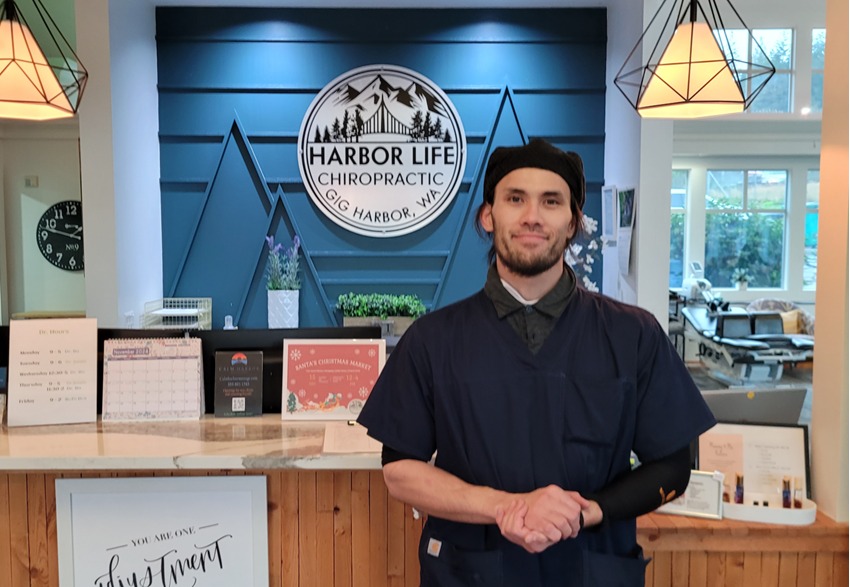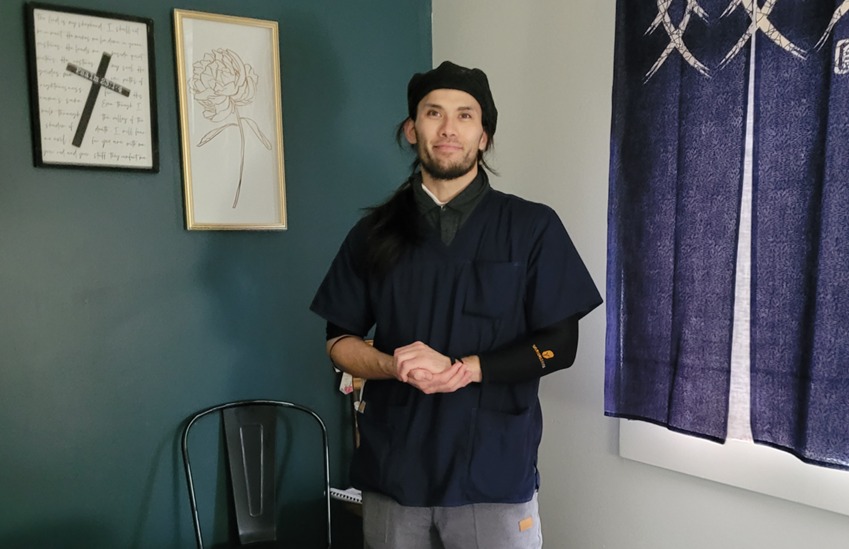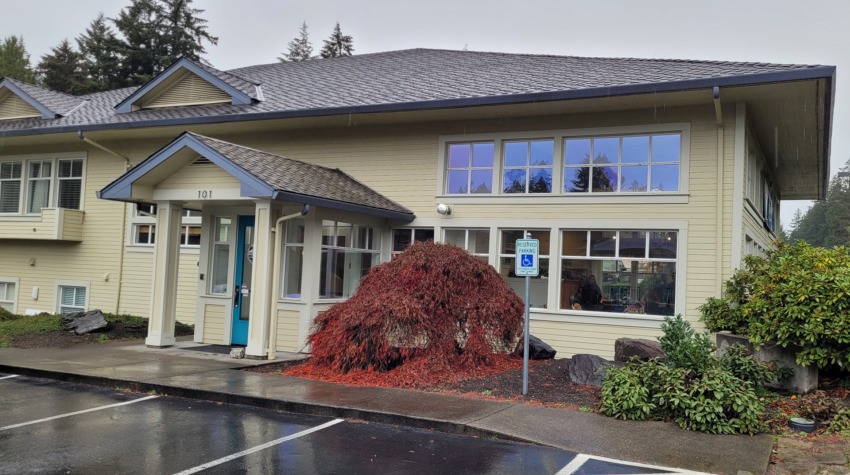Mountain And Sea Massage of Gig Harbor
Now treating:
- Auto injuries, PIP claims
- Work injuries accepted
- Headaches and migraines
- Sports related injuries
- Muscular adhesions / knots
- Low back pain
What We Do:
We navigate fascia w/ focus on aligning bone and joint patterns to relieve tension in the CNS and muscular pathways and/or creating new connections through repetition. We seek to offer pain relief therapy through Structural integration, strategized with Applied Kinesiology: Movement Mechanics (Kinetics), proprioceptive* coordination of the body (neural coherence), and assisted awareness of the NeuroMuscular system (balance and strength). *Your body's ability to sense its own position and movements in space.
The adaptive Bodywork approach integrates Martial Arts, Bodybuilding, & Kinetic philosophy, to “map the body” toward functional stability. Mobility Massage is an experience that engages Range of Motion dynamics with joint supportive movement to enhance Posture and Circulation.
How We Can Help You:
An initial visit generally consists of body assessment, establishing postural boundaries, & discussing the ideal outcome (pain relief, enhanced range of motion, better breathing, etc.) for each individual we work with.
Learning the individual’s body awareness is the primary objective, and it is to assist an adaptive approach for Long-Term improvements. My theory: offering energy to “stimulate the system,” coordinating the fascial network to form body coherence, integrating trigger points and reflexology to localize circulation patterns, and “teaching the body” to “hear the brain,” through proprioceptive techniques; including ‘bone tapping’ and ‘breath work.’
What Sets Us Apart From Other Massage Practitioners?
- What we offer is not a typical massage. Not insulting traditional massage, just differentiated from standard approaches.
- Our chief interest is in miracles, which indicates radical healing and actualized improvements in 'pain and mobility' leading to a greater well-being.
- I do believe Healing is perceptive.
- The concept of the placebo effect indicates the power of thought, and Functional awareness is a process that can be cultivated over the long-term.
- Charging the energy system is equivalent to exercise. Movement triggers the body through stimulation, + stabilizing movement creates positive feedback loops.
- Addressing the body's structural components is the basis for anatomy training and structural integration, or 'flow.' Integrating the neuromuscular awareness through consistent “cycles” of movement patterns.
- Deliberate awareness is meant to Educate and prime the mind-body connectivity
- My ambition is to help everyone feel their best and build a healthy frame w/ effective touch and structural balance
A Common Example: Movement Patterns Influence Energy Pathways
Left shoulder pain: the body stabilizes the skeleton through inter-related connections throughout the body. Tendons, ligaments, muscles, bones, nerves, blood, all are contributing to homeostasis and function.
The pec minor is a muscle commonly associated w/ nerve entrapment, as it can become constricted, limiting circulation from neck to sternum, thorax to lumbar, hips to legs, feet to brain… to restore movements such as reaching, lifting, walking, sitting, etc., the body will establish “holding patterns” to sustain everyday function, and this usually will cause rotational compensations in the vertebrae.. these leverages in movement are reflected in the ribcage, and the neuromuscular relay will affect the sacrum. Essentially, posture will adapt to habitual function. And that is why most “injury” is repetitive stress related. Beneficially, these “stress routes” can be redirected through the fascial network at the source: brain to body to breath.
To correct an isolated area, the ideal place to improve is usually our core, including the thorax, glutes, hip flexors, and knees.
Initially, I will address the “local awareness” of patient tension/discomfort, by “tracing” the tissues along the joint network. This “sensory surfacing” provides a clearer path to “ open and close” (flex/extend, stretch/shorten, stimulate/relax) the affected areas.
As most pain is observed when nociceptors (pain detectors) are 'trapped' somewhere along the “brain map,” becoming more aware of the body leads to “lessened” nerve interference. This is because coiled tissue elicits entrapment along the pathways, causing impingement, weakening connections, & eventually muscles will atrophy rather than struggle.
My focus is to “align the frame & mobilize the tissue.” My techniques are an amalgam based upon personal experience (injury, fitness, study), working with a variety of body types and injuries, and “learning” athletic movements. This schema (visual aid) in my mind, is used to simulate the sensory that might cause pain, in order to strategize a “systemic redirecting.” Specifically, through basic motor function.
Pressure Test Your Body
The reason for pain is a lack of circulating flow (blood, oxygen, chi/electric impulses). The 'cold nerves' are very sensitive, and it is because the tissue is bound in a protective state, to best preserve functional energy to the unit (limb, organelle, “side”of body).
Tracing The Origin Of Your Pain
By tracing the origin, and seeking localized association with the nervous system, the objective becomes harmonious integration in the body. In the left shoulder pain example, this indicates, “buffering the connections” from thumb, wrist, elbow, ribcage, jaw, and shoulder. This method aims to stabilize the sensory which may lessen the anxiety relative to pain. For all of us people who enjoy NOT being in constant duress, establishing a resting state to self-govern, with coordinated circulation can calm cognitive stress.
Bring Peace to Your Perception
Tactics such as bone tapping and self-tapotement help bring awareness to the body and active breath work reframes the response we experience during pain/sensory interruptions.
Ultimately, our bodies are most effective, when we can manage and transmute distress into eustress/positive stress, which helps us grow toward balance. My core desire is directed toward helping those who need help.
Schedule your session & rediscover your familiar frame. Feel the difference.
Special Needs Massage & Autism
For the last year I have been working with a special needs patient in Gig Harbor, 'Patient B', who has Down syndrome and Autism. When I first met him, he was very hunched, anxious, and stiff. My reason for inquiring if I could help him was due to a previous patient I had, 'Patient A', who had Autism and Angel Man syndrome. I recognized the behaviour tendencies and mannerisms.
This is what indicated to me, along with my own personal experiences with energetics (anxiousness, 'tics', ungrounded electricity), that I could offer help.
As of recently, Patient B has ceased some of the original disturbed mannerisms, and his posture has drastically improved, along with his strength. My theory is based upon my understanding of the body’s energy systems, fascial networks, cognitive functions, and most importantly, my Faith.
If you have a special needs person, including physical disability, please schedule a session with me, and let’s discover if I can benefit the person.
What They Are Saying
I’ve been to countless massage therapists and nobody has come
close to Eugene.
He’s not trying to loosen your muscles. He’s
trying to fix why they’re tight in the first place. It’s really
more like physical therapy but you leave totally relaxed and
relieved. Eugene is a pro. Couldn’t recommend more.
- Zach Abraham
I cannot recommend Eugene enough!
Be warned - this is not your typical massage.
This is the type of massage where you need to trust the
process and not over think it. You will feel amazing
afterwards!
- Stephanie Howard, Gig Harbor, December, 2024
I have seen amazing results with his work and have recommended him to multiple people.
I was having shoulder pain for years with decreased range of
motion. I had tried injections, physical therapy, acupuncture
and standard massage, all with no results. He gave me back
full range of motion with his techniques. Eugene’s
understanding of the body and dedication to learning has been a
blessing for my quality of life. Highly recommend!
- Michelle Bennison, Gig Harbor, January, 2024
Let me explain...
I first met Eugene well over a year ago when I was starting a new health focus. At 56 and 270 pounds I had begun a diet and walking program. My feet, knees, and hips were killing me. I felt if I wanted to avoid injury and keep focused I would have to invest in some kind of help. What I didn't know is that I really needed movement recovery. What I learned is that my balance was skewed by long held movement patterns that created pain when stressed.
After my first session my perception of balance was reset. I actually felt like I was leaning to one side - so weird. Read more...
Massage Services in the Gig Harbor Area
Serving massage patients in Gig Harbor, Tacoma, Purdy, Olalla, Longbranch and the Key Peninsula.
Massage Gift Certificates
Unlock Strength and Mobility. Give the gift of performance and recovery with our Mountain and Sea Mobility Massage Gift Certificate. Designed for those who demand the most from their bodies, this massage goes beyond relaxation—it’s about unlocking potential. Whether it’s tackling stiffness, enhancing range of motion, or countering pain, this session is for “ready” people who know the importance of staying strong, agile, and prepared for the next challenge. This isn’t just a massage - it’s an ‘iron sharpening iron’ edge.Give the gift of mobility, because progress doesn’t come from standing still.
Purchase Gift Certificates

About Mountain and Sea Massage










